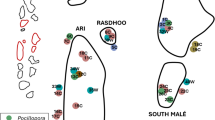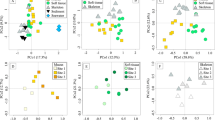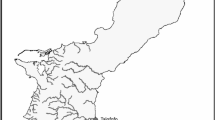Abstract
Coral mucus, tissue, and skeleton harbor compositionally different microbiota, but how these coral compartments shape the microbial evolution remains unexplored. Here, we sampled bacteria inhabiting a prevalent coral species Platygyra acuta and sequenced genomes of 234 isolates comprising two populations in Rhodobacteraceae, an alphaproteobacterial lineage representing a significant but variable proportion (5–50%) of the coral microbiota. The Ruegeria population (20 genomes) contains three clades represented by eight, six, and six isolates predominantly sampled from the skeleton (outgroup), mucus (clade-M), and skeleton (clade-S), respectively. The clade-M possesses functions involved in the utilization of coral osmolytes abundant in the mucus (e.g., methylamines, DMSP, taurine, and L-proline), whereas the clade-S uniquely harbors traits that may promote adaptation to the low-energy and diurnally anoxic skeleton (e.g., sulfur oxidation and swimming motility). These between-clade genetic differences were largely supported by physiological assays. Expanded analyses by including genomes of 24 related isolates (including seven new genomes) from other marine environments suggest that clade-M and clade-S may have diversified in non-coral habitats, but they also consolidated a key role of distinct coral compartments in diversifying many of the above-mentioned traits. The unassigned Rhodobacteraceae population (214 genomes) varies only at a few dozen nucleotide sites across the whole genomes, but the number of between-compartment migration events predicted by the Slatkin–Maddison test supported that dispersal limitation between coral compartments is another key mechanism diversifying microbial populations. Collectively, our results suggest that different coral compartments represent ecologically distinct and microgeographically separate habitats that drive the evolution of the coral microbiota.
Similar content being viewed by others
Log in or create a free account to read this content
Gain free access to this article, as well as selected content from this journal and more on nature.com
or
Data availability
The assembled genomic sequences and raw reads of the coral-associated Ruegeria population, the seven Ruegeria isolates from non-coral marine habitats, and the coral-associated unassigned Rhodobacteraceae population are made publicly available at NCBI under GenBank assembly accession number PRJNA596594, PRJNA682389, and PRJNA596592, respectively.
References
Bourne DG, Morrow KM, Webster NS. Insights into the coral microbiome: underpinning the health and resilience of reef ecosystems. Annu Rev Microbiol. 2016;70:317–40.
Ainsworth TD, Thurber RV, Gates RD. The future of coral reefs: a microbial perspective. Trends Ecol Evol. 2010;25:233–40.
Huettel M, Wild C, Gonelli S. Mucus trap in coral reefs: formation and temporal evolution of particle aggregates caused by coral mucus. Mar Ecol Prog Ser. 2006;307:69–84.
Coffroth M. Mucous sheet formation on poritid corals: an evaluation of coral mucus as a nutrient source on reefs. Mar Biol. 1990;105:39–49.
Brown BE, Bythell JC. Perspectives on mucus secretion in reef corals. Mar Ecol Prog Ser. 2005;296:291–309.
Sweet M, Croquer A, Bythell J. Bacterial assemblages differ between compartments within the coral holobiont. Coral Reefs. 2011;30:39–52.
Yancey PH. Organic osmolytes as compatible, metabolic and counteracting cytoprotectants in high osmolarity and other stresses. J Exp Biol. 2005;208:2819–30.
Burg MB, Ferraris JD. Intracellular organic osmolytes: function and regulation. J Biol Chem. 2008;283:7309–13.
Singh LR, Dar TA, editors. Cellular osmolytes: from chaperoning protein folding to clinical perspectives. 1st ed. Singapore: Springer Nature Singapore Pte Ltd.; 2017.
Yancey PH, Heppenstall M, Ly S, Andrell RM, Gates RD, Carter VL, et al. Betaines and dimethylsulfoniopropionate as major osmolytes in cnidaria with endosymbiotic dinoflagellates. Physiol Biochem Zool. 2010;83:167–73.
Mayfield AB, Gates RD. Osmoregulation in anthozoan—dinoflagellate symbiosis. Compar Biochem Physiol A. 2007;147:1–10.
Rublee PA, Lasker HR, Gottfried M, Roman MR. Production and bacterial colonization of mucus from the soft coral Briarium asbestinum. Bull Mar Sci. 1980;30:888–93.
Wild C, Woyt H, Huettel M. Influence of coral mucus on nutrient fluxes in carbonate sands. Mar Ecol Prog Ser. 2005;287:87–98.
Coles SL, Strathmann R. Observations on coral mucus “flocs” and their potential trophic significance. Limnol Oceanogr. 1973;18:673–8.
Pernice M, Raina J-B, Rädecker N, Cárdenas A, Pogoreutz C, Voolstra CR. Down to the bone: the role of overlooked endolithic microbiomes in reef coral health. ISME J. 2020;14:325–34.
Falini G, Fermani S, Goffredo S. Coral biomineralization: a focus on intra-skeletal organic matrix and calcification. Semin Cell Dev Biol. 2015;46:17–26.
Constantz B, Weiner S. Acidic macromolecules associated with the mineral phase of scleractinian coral skeletons. J Exp Zool. 1988;248:253–8.
Muscatine L, Goiran C, Land L, Jaubert J, Cuif JP, Allemand D. Stable isotopes (delta C-13 and delta N-15) of organic matrix from coral skeleton. Proc Natl Acad Sci USA. 2005;102:1525–30.
Sorek M, Díaz-Almeyda EM, Medina M, Levy O. Circadian clocks in symbiotic corals: the duet between Symbiodinium algae and their coral host. Mar Genom. 2014;14:47–57.
Agostini S, Suzuki Y, Higuchi T, Casareto B, Yoshinaga K, Nakano Y, et al. Biological and chemical characteristics of the coral gastric cavity. Coral Reefs. 2012;31:147–56.
Rosenberg E, Koren O, Reshef L, Efrony R, Zilber-Rosenberg I. The role of microorganisms in coral health, disease and evolution. Nat Rev Microbiol. 2007;5:355–62.
Ritchie KB. Bacterial symbionts of corals and Symbiodinium. In: Rosenberg E, Gophna U editors. Beneficial microorganisms in multicellular life forms. 1st ed. Berlin Heidelberg: Springer-Verlag Berlin Heidelberg; 2012. pp 139–50.
Apprill A, Weber LG, Santoro AE. Distinguishing between microbial habitats unravels ecological complexity in coral microbiomes. mSystems. 2016;1:e00143–00116.
Pollock FJ, McMinds R, Smith S, Bourne DG, Willis BL, Medina M, et al. Coral-associated bacteria demonstrate phylosymbiosis and cophylogeny. Nat Commun. 2018;9:1–13.
Shapiro BJ, Friedman J, Cordero OX, Preheim SP, Timberlake SC, Szabó G, et al. Population genomics of early events in the ecological differentiation of bacteria. Science. 2012;336:48–51.
Youngblut ND, Wirth JS, Henriksen JR, Smith M, Simon H, Metcalf WW, et al. Genomic and phenotypic differentiation among Methanosarcina mazei populations from Columbia River sediment. ISME J. 2015;9:2191–205.
Wielgoss S, Didelot X, Chaudhuri RR, Liu X, Weedall GD, Velicer GJ, et al. A barrier to homologous recombination between sympatric strains of the cooperative soil bacterium Myxococcus xanthus. ISME J. 2016;10:2468–77.
Chase AB, Arevalo P, Brodie EL, Polz MF, Karaoz U, Martiny JB. Maintenance of sympatric and allopatric populations in free-living terrestrial bacteria. Mbio. 2019;10:e02361–02319.
Huggett MJ, Apprill A. Coral microbiome database: integration of sequences reveals high diversity and relatedness of coral-associated microbes. Environ Microbiol Rep. 2019;11:372–85.
Apprill A, Marlow HQ, Martindale MQ, Rappe MS. The onset of microbial associations in the coral Pocillopora meandrina. ISME J. 2009;3:685–99.
Epstein HE, Torda G, Munday PL, van Oppen MJH. Parental and early life stage environments drive establishment of bacterial and dinoflagellate communities in a common coral. ISME J. 2019;13:1635–8.
Freire I, Gutner-Hoch E, Muras A, Benayahu Y, Otero A. The effect of bacteria on planula-larvae settlement and metamorphosis in the octocoral Rhytisma fulvum fulvum. PLoS ONE. 2019;14:e0223214.
Miura N, Motone K, Takagi T, Aburaya S, Watanabe S, Aoki W, et al. Ruegeria sp. strains isolated from the reef-building coral Galaxea fascicularis inhibit growth of the temperature-dependent pathogen Vibrio coralliilyticus. Mar Biotechnol. 2019;21:1–8.
Apprill A, Hughen K, Mincer T. Major similarities in the bacterial communities associated with lesioned and healthy Fungiidae corals. Environ Microbiol. 2013;15:2063–72.
Sekar R, Kaczmarsky LT, Richardson LL. Microbial community composition of black band disease on the coral host Siderastrea siderea from three regions of the wider Caribbean. Mar Ecol Prog Ser. 2008;362:85–98.
Casey JM, Connolly SR, Ainsworth TD. Coral transplantation triggers shift in microbiome and promotion of coral disease associated potential pathogens. Sci Rep. 2015;5:11903–11903.
Tsang RHL, Ang PO. Resistance to temperature stress and Drupella corallivory may promote the dominance of Platygyra acuta in the marginal coral communities in Hong Kong. Mar Environ Res. 2019;144:20–27.
Tam TW, Ang PO Jr. Repeated physical disturbances and the stability of sub‐tropical coral communities in Hong Kong, China. Aquat Conserv. 2008;18:1005–24.
Ang Jr PO, Choi LS, Choi MM, Cornish A, Fung HL, Lee MW et al. Hong Kong. In: Centre JWR editors. Status of coral reefs of the East Asian Seas region: 2004. Tokyo: Ministry of the Environment; 2005. pp 121–52.
Luo H, Moran MA. Evolutionary ecology of the marine Roseobacter clade. Microbiol Mol Biol Rev. 2014;78:573–87.
Pujalte MJ, Lucena T, Ruvira MA, Arahal DR, Macián MC. The family Rhodobacteraceae. In: Rosenberg E, DeLong EF, Lory S, Stackebrandt E, Thompson F editors. The Prokaryotes: alphaproteobacteria and Betaproteobacteria. 4th ed. Berlin Heidelberg: Springer-Verlag Berlin Heidelberg; 2014. pp 439–512.
Johannes RE, Wiebe WJ. Method for determination of coral tissue biomass and composition. Limnol Oceanogr. 1970;15:822–4.
Emms DM, Kelly S. OrthoFinder: phylogenetic orthology inference for comparative genomics. Genome Biol. 2019;20:1–14.
Nguyen LT, Schmidt HA, von Haeseler A, Minh BQ. IQ-TREE: a fast and effective stochastic algorithm for estimating maximum-likelihood phylogenies. Mol Biol Evol. 2015;32:268–74.
Achtman M, Wagner M. Microbial diversity and the genetic nature of microbial species. Nat Rev Microbiol. 2008;6:431–40.
Feil EJ, Spratt BG. Recombination and the population structures of bacterial pathogens. Annu Rev Microbiol. 2001;55:561–90.
Wang X, Zhang Y, Ren M, Xia T, Chu X, Liu C, et al. Cryptic speciation of a pelagic Roseobacter population varying at a few thousand nucleotide sites. ISME J. 2020;14:3106–19.
Lawson DJ, Hellenthal G, Myers S, Falush D. Inference of population structure using dense haplotype data. PLoS Genet. 2012;8:e1002453.
Didelot X, Wilson DJ. ClonalFrameML: efficient inference of recombination in whole bacterial genomes. PLoS Comput Biol. 2015;11:e1004041.
Excoffier L, Lischer HE. Arlequin suite ver 3.5: a new series of programs to perform population genetics analyses under Linux and Windows. Mol Ecol Resour. 2010;10:564–7.
Sun Y, Luo H. Homologous recombination in core genomes facilitates marine bacterial adaptation. Appl Environ Microbiol. 2018;84:e02545–02517.
Librado P, Vieira FG, Rozas J. BadiRate: estimating family turnover rates by likelihood-based methods. Bioinformatics. 2011;28:279–81.
Slatkin M, Maddison WP. A cladistic measure of gene flow inferred from the phylogenies of alleles. Genetics 1989;123:603–13.
Jain C, Rodriguez-R LM, Phillippy AM, Konstantinidis KT, Aluru S. High throughput ANI analysis of 90K prokaryotic genomes reveals clear species boundaries. Nat Commun. 2018;9:1–8.
Lohr KE, Khattri RB, Guingab-Cagmat J, Camp EF, Merritt ME, Garrett TJ, et al. Metabolomic profiles differ among unique genotypes of a threatened Caribbean coral. Sci Rep. 2019;9:1–11.
Hill R, Li C, Jones A, Gunn J, Frade P. Abundant betaines in reef-building corals and ecological indicators of a photoprotective role. Coral Reefs. 2010;29:869–80.
Gowrishankar J. Nucleotide sequence of the osmoregulatory proU operon of Escherichia coli. J Bacteriol. 1989;171:1923–31.
Chandravanshi M, Gogoi P, Kanaujia SP. Computational characterization of TTHA0379: A potential glycerophosphocholine binding protein of Ugp ATP-binding cassette transporter. Gene. 2016;592:260–8.
Ziegler C, Bremer E, Krämer R. The BCCT family of carriers: from physiology to crystal structure. Mol Microbiol. 2010;78:13–34.
Geiger O, López-Lara IM, Sohlenkamp C. Phosphatidylcholine biosynthesis and function in bacteria. Biochim Biophys Acta Mol Cell Biol Lipids. 2013;1831:503–13.
Lidbury I, Kimberley G, Scanlan DJ, Murrell JC, Chen Y. Comparative genomics and mutagenesis analyses of choline metabolism in the marine Roseobacter clade. Environ Microbiol. 2015;17:5048–62.
Thole S, Kalhoefer D, Voget S, Berger M, Engelhardt T, Liesegang H, et al. Phaeobacter gallaeciensis genomes from globally opposite locations reveal high similarity of adaptation to surface life. ISME J. 2012;6:2229–44.
Wang Z, Klipfell E, Bennett BJ, Koeth R, Levison BS, DuGar B, et al. Gut flora metabolism of phosphatidylcholine promotes cardiovascular disease. Nature. 2011;472:57–63.
Jones M, Talfournier F, Bobrov A, Grossmann JG, Vekshin N, Sutcliffe MJ, et al. Electron transfer and conformational change in complexes of trimethylamine dehydrogenase and electron transferring flavoprotein. J Biol Chem. 2002;277:8457–65.
Chen Y. Comparative genomics of methylated amine utilization by marine Roseobacter clade bacteria and development of functional gene markers (tmm, gmaS). Environ Microbiol. 2012;14:2308–22.
Schäfer H, McDonald IR, Nightingale PD, Murrell JC. Evidence for the presence of a CmuA methyltransferase pathway in novel marine methyl halide‐oxidizing bacteria. Environ Microbiol. 2005;7:839–52.
McNicholas PM, Chiang RC, Gunsalus RP. Anaerobic regulation of the Escherichia coli dmsABC operon requires the molybdate‐responsive regulator ModE. Mol Microbiol. 1998;27:197–208.
Loschi L, Brokx SJ, Hills TL, Zhang G, Bertero MG, Lovering AL, et al. Structural and biochemical identification of a novel bacterial oxidoreductase. J Biol Chem. 2004;279:50391–50400.
Hillyer KE, Dias DA, Lutz A, Wilkinson SP, Roessner U, Davy SK. Metabolite profiling of symbiont and host during thermal stress and bleaching in the coral Acropora aspera. Coral Reefs. 2017;36:105–18.
Rösgen J. Molecular basis of osmolyte effects on protein and metabolites. Methods Enzymol. 2007;428:459–86.
Cunliffe M. Correlating carbon monoxide oxidation with cox genes in the abundant marine Roseobacter clade. ISME J. 2011;5:685–91.
Bartling P, Vollmers J, Petersen J. The first world swimming championships of Roseobacters—phylogenomic insights into an exceptional motility phenotype. Syst Appl Microbiol. 2018;41:544–54.
Michael V, Frank O, Bartling P, Scheuner C, Goker M, Brinkmann H, et al. Biofilm plasmids with a rhamnose operon are widely distributed determinants of the ‘swim-or-stick’ lifestyle in roseobacters. ISME J. 2016;10:2498–513.
Armitage JP. Behavioural responses of bacteria to light and oxygen. Arch Microbiol. 1997;168:249–61.
Jorgensen NOG. Uptake of urea by estuarine bacteria. Aquat Micro Ecol. 2006;42:227–42.
Pernice M, Raina J-B, Rädecker N, Cárdenas A, Pogoreutz C, Voolstra CR. Down to the bone: the role of overlooked endolithic microbiomes in reef coral health. ISME J. 2019: 1–10.
Krajewska B, Ureases I. Functional, catalytic and kinetic properties: a review. J Mol Catal B Enzym. 2009;59:9–21.
Cheng L, Cord-Ruwisch R. In situ soil cementation with ureolytic bacteria by surface percolation. Ecol Eng. 2012;42:64–72.
Cho BC, Park MG, Shim JH, Azam F. Significance of bacteria in urea dynamics in coastal surface waters. Mar Ecol Prog Ser. 1996;142:19–26.
Jin D, Zhao SG, Zheng N, Beckers Y, Wang JQ. Urea metabolism and regulation by rumen bacterial urease in ruminants—a review. Ann Anim Sci. 2018;18:303–18.
Collier JL, Baker KM, Bell SL. Diversity of urea-degrading microorganisms in open-ocean and estuarine planktonic communities. Environ Microbiol. 2009;11:3118–31.
Biscéré T, Ferrier-Pagès C, Grover R, Gilbert A, Rottier C, Wright A, et al. Enhancement of coral calcification via the interplay of nickel and urease. Aquat Toxicol. 2018;200:247–56.
Crossland C, Barnes D. The role of metabolic nitrogen in coral calcification. Mar Biol. 1974;28:325–32.
Goodkin NF, Switzer AD, Mccorry D, Devantier L, True J, Hughen KA, et al. Coral communities of Hong Kong: long-lived corals in a marginal reef environment. Mar Ecol Prog Ser. 2011;426:185–96.
Bernasconi R, Stat M, Koenders A, Paparini A, Bunce M, Huggett MJ. Establishment of coral-bacteria symbioses reveal changes in the core bacterial community with host ontogeny. Front Mirobiol. 2019;10:1529.
Chu X, Li S, Wang S, Luo D, Luo H. Gene loss through pseudogenization contributes to the ecological diversification of a generalist Roseobacter lineage. ISME J. 2020;15:489–502.
Gardner SN, Slezak T, Hall BG. kSNP3. 0: SNP detection and phylogenetic analysis of genomes without genome alignment or reference genome. Bioinformatics. 2015;31:2877–8.
Krzywinski M, Schein JE, Birol I, Connors JM, Gascoyne RD, Horsman D, et al. Circos: an information aesthetic for comparative genomics. Genome Res. 2009;19:1639–45.
Acknowledgements
We thank Ryan Ho-Leung Tsang for the coral sample collection, Tsz-Yan Ng for guiding coral sample processing, Xiao Chu and Shuangfei Zhang for their help on bacteria cultivation, Hao Zhang and Minglei Ren for their help in data analysis, and Xinqin Lin for her advice in experimental design. We thank Xiao Chu, Minglei Ren, and Zhichao Zhou for providing isolates from the brown algae ecosystem, sediments, and mangrove ecosystem. This work was supported by the Shenzhen Science and Technology Committee (JCYJ20180508161811899), the National Natural Science Foundation of China (41776129), the Hong Kong Environment and Conservation Fund (15/2016), the Hong Kong Research Grants Council General Research Fund (14163917), and the Hong Kong Research Grants Council Area of Excellence Scheme (AoE/M-403/16).
Author information
Authors and Affiliations
Corresponding author
Ethics declarations
Conflict of interest
The authors declare no competing interests.
Additional information
Publisher’s note Springer Nature remains neutral with regard to jurisdictional claims in published maps and institutional affiliations.
Supplementary information
Rights and permissions
About this article
Cite this article
Luo, D., Wang, X., Feng, X. et al. Population differentiation of Rhodobacteraceae along with coral compartments. ISME J 15, 3286–3302 (2021). https://doi.org/10.1038/s41396-021-01009-6
Received:
Revised:
Accepted:
Published:
Issue date:
DOI: https://doi.org/10.1038/s41396-021-01009-6
This article is cited by
-
Genomic characteristics and phylogenetic relationships of Cutibacterium acnes breast milk isolates
BMC Microbiology (2025)
-
Phototrophic bacteria as potential probiotics for corals
npj Biodiversity (2025)
-
Structural Dynamics of the Skin-Associated Microbiome of the Sea Cucumber Holothuria scabra During Integument Ulceration and Recovery
Current Microbiology (2025)
-
The coral microbiome in sickness, in health and in a changing world
Nature Reviews Microbiology (2024)
-
Probiotics reshape the coral microbiome in situ without detectable off-target effects in the surrounding environment
Communications Biology (2024)



